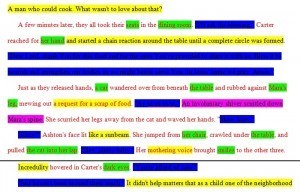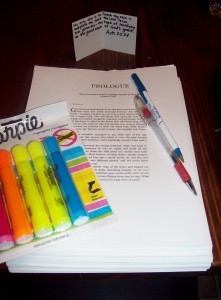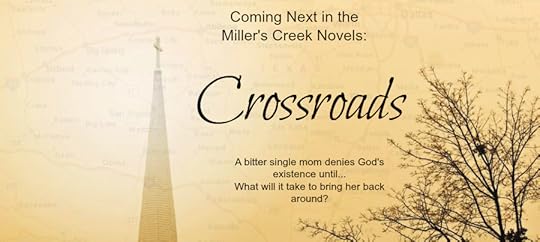A Free Sneak Peek at My Editing Process
It’s been said that books aren’t written, but re-written.
I wish I’d known this when I wrote my first book, Texas Roads. I naively assumed that I would write the book, and that would be the end. But as I read through the lousy (and yes, I truly mean lousy) rough draft of the story I literally wanted to cry. My work was far from over.
I went back to school in learning the craft of writing, this time snatching up books on editing and revision. (See below for a list of my favorite books on this topic.) Through this study I learned and created my system of turning a rough draft into a marketable story. So I hope you enjoy this free sneak peek at my editing process.
Sneak Peek at My OCD
I know I’m a bit OCD about the revision portion of writing a book (which probably explains why its ‘teeth-pulling-without-anesthesia’ difficult), but I also believe it makes the difference between a so-so story and a great story. Though I dread–and complain and whine–throughout the process, I’m always glad afterwards, because the story has come alive on the pages.
Color-Coding Dialogue, Thought, Action, Description and Emotion

I look for this kind of balance in the manuscript.
One thing I’ve learned to do in edits and re-writes is use the high-lighter in Microsoft Word to mark what I’m checking on that particular round of edits.
That way I can tell with a glance if I have a good balance, or if I need to make changes. I particularly watch out for large chunks of description, internal thought, action, and dialogue. I picked up this part of my process from a course I took with Margie Lawson.
Why? Because readers skim too much description, action, and thought, and too much dialogue is like watching a tennis match with nothing to interrupt the volleys. Readers need action, internal thought, body language, and vocal cues to give meaning and context to the conversation.
I also only need and want a little emotion. Too much and the novel reads like a melodramatic silent movie. (Think Dudley Do-Right…)

The rough draft of THE WAY OF GRACE prior to color-coded edits.
At one time, I printed out the manuscript and completed this part of the process using regular high-lighters, as evidenced by the picture of the rough draft of The Way of Grace to the right. But eventually the cost of paper and ink led me to my current system.
Color-Coding Sensory Detail
I also use color-coding to make sure I’ve included all the senses–sight, sound, taste, smell, touch/feeling, and intuition–in each chapter. My motivation for this sensory detail is that it really helps ground the reader in the scene, as they can see, hear, smell, taste, feel, and intuit all the point-of-view character is experiencing in the story.
Other Passes
I make multiple passes through the manuscript (sometimes using the Control F or ‘Find’ function) to check the following:
Over-used Words/Pet Phrases – Do you know how easy it is to overuse words like ‘turned’ and ‘walked’ and ‘laughed?’ I attempt in this part of the process to ramp up my verbiage with stronger words like ‘pivoted’ and ‘tiptoed’ and ‘guffawed.’ I also watch out for cliches, and try to re-write them in a way that’s fresh for the reader.
Over-use of Adverbs and Adjectives – While these add color and spice, they can also weaken the description if over-used. I think of it as adding garlic to a meal–not enough and it’s bland; too much and it’s inedible. I think it was Mark Twain who said: “If you find an adjective, kill it!”
Story Flow – Already in my editing/re-writing process for the next Miller’s Creek book, Crossroads , I found a break in the story flow. This necessitated the writing of a new chapter, but now the story doesn’t have a huge jump that leaves out important story details.
Goal, Motivation, and Conflict – These three things are must-have’s in a story scene. The goal is just what it sounds like: the main character’s goal for what he/she wants to accomplish during that scene. The motivation is why he/she wants what they want. And the conflict is what thing or things stand between them and the completion of their goal. Without these three crucial components there is no story. (Writer friends, if you haven’t read Debra Dixon’s excellent book on goal, motivation, and conflict, check it out HERE .)
Setting – One of the things I really have to watch is making sure that the reader gets grounded in the location of the scene without dumping large chunks of description. Earlier eras of literature did this–think Jane Austen or the Bronte sisters–but today’s reader wants faster-paced writing. Setting includes both the where and when of a particular chapter in the story.
A Variety of Body Language Cues (lips, eyes, mouth, facial expressions, jaw, neck/shoulders, chest, abdomen, legs, arms, hands, feet, fingers, toes) – Did you know that it’s impossible for us NOT to communicate? And a large percentage of our communication is non-verbal. The rapidity of eye blinks can indicate attraction. A slight twitch of the eyebrow indicates deception. If you want a fascinating course of study, bone up on body language!
A Variety of Dialogue Cues – The manner in which we speak is also a huge indicator of what we really mean. It’s possible to say one thing, but our pitch, volume, rate of speech, quality, tone, or inflection can make the person listening interpret it differently than we intended. Most fiction writing today leaves out tags like ‘he said,’ but the reader often needs a cue to interpret the scene.
Point-of-view Character – We’ve probably all read books that jumped around from character to character. This makes for difficult reading. I do my best to make sure that each scene has only one point-of-view character. But I also try to include an equal number of scenes between the hero and the heroine. Why? I think it makes the story more interesting. It lets the reader know what each one is thinking, and allows the reader to connect to both characters.
Over-use of Pronouns and/or Proper Nouns – It’s all too easy when writing the rough draft to ‘he’ and ‘she’ all over the place, so as I make edits, I try to cut as many pronouns as possible without affecting the meaning. The same can be said of using proper names. They can be used too much or too little.
Hooks and Endings – One thing that keeps a reader turning pages is hooks that pull them into the scene and endings that make them want to go on to the next chapter. It’s been said that story openings sell the story, but story endings sell the next book. So it behooves authors to pay extra-careful attention to the story openings and endings.
Character Voice – During my pre-writing process, I fill out lengthy character charts for each major character, and even subject the characters to a battery of personality tests. My reason for this is to get under the skin of that character so I know them inside and out. But during the edits phase, I’m especially careful of character voice. A guy doesn’t talk like a girl. For that matter, two girls don’t necessarily have the same vocal characterization. I want to make sure that each character has their own voice and that it’s consistent throughout the story.
MRUs – Another thing I check is motivation-reaction units or MRUs. These were first introduced by Dwight V. Swain in his book, Techniques of the Selling Writer . In a nutshell, it means getting things in the right order. For example, visceral emotion (neck hairs standing on end, pulse racing, head swimming, etc.) is usually the first reaction to a stimulus, followed by internal thought, action, then dialogue. If these aren’t in order, the reader will notice that something feels off, even if they can’t exactly put their finger on it.
Redundancy – It’s easy to overstate something in story. Perhaps it’s a character who rehashes the same thought every other page. Or maybe a character does something which I then explain in dialogue or internal thought. It’s much better to resist the urge to explain and trust the reader to get it the first time.
As stands to reason, with each pass through the story there are fewer changes made. And with each book, I’m able to combine some of the above for fewer passes, though not necessarily less time. I try to finish up the entire process with a complete read-through from beginning to end, and I read the book out loud.
At this point, if not before, I send the story to editors and beta readers to get extra eyes on the book. Why? Mainly because by this time, I’m far too close to the manuscript to be completely objective.
The human brain works in such a way that I continue to read the story the way I first concocted it in my head. So something which might make sense to me will leave the reader scratching his or her head. These kind folks also help locate misspellings, word usage, and punctuation errors I may have missed.
I hope you’ve enjoyed this sneak peek into my editing process. As you can tell, it’s very detailed and takes weeks.
And just so you know, the book still isn’t ready for publication at this point. Next comes the formatting, which involves two different processes, one for print and one for eBooks.
And you thought the job of a writer was easy… 
My Favorite Editing and Revision Books
Here’s a list of my favorite books on this sub-topic in the craft of writing. (NOTE: These are Amazon affiliate links, which means if you purchase a product via these links, I earn a small cents-on-the-dollar commission. Thank you for your support!)
Revision and Self-Editing by James Scott Bell
Self-Editing for Fiction Writers by Renni Browne and Dave King
The First Five Pages by Noah Lukeman
WRITING UPDATE: As of the writing of this post, I’m almost halfway through the first round of edits to Crossroads. I hope to finish up the process by the end of January.











CatBryant.com ~ Journey Blog
- Cathy Bryant's profile
- 390 followers




